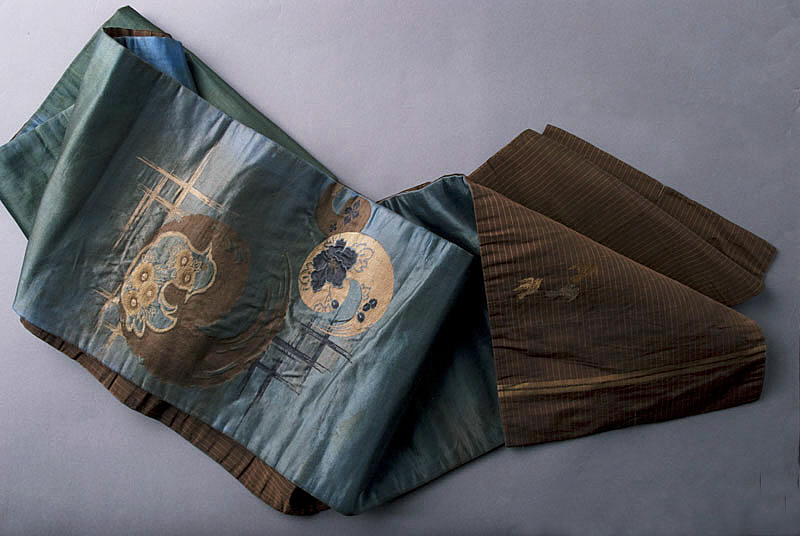
Past Exhibition
Textured Lives
Japanese Immigrant Clothing from the Plantations of Hawai`i
Extras

Activity Guide
Download the activity guide produced by JANM’s Education Unit for the exhibition. It includes some activities you can do at home!
Discover Nikkei Resources
JANM’s DiscoverNikkei.org website is a treasure trove of materials and resources on Nikkei (Japanese emigrants and their descendants) life, history, culture, and community around the world. It is a community-based project that partners with organizations and individuals throughout the Americas to share Nikkei-related community and personal stories, events, and more in four languages—English, Japanese, Spanish, and Portuguese.
Check out the articles and life history video interview clips related to the exhibition on Discover Nikkei below.
Extras
February 28 - August 22, 2010
Japanese American National Museum
Extras

Activity Guide
Download the activity guide produced by JANM’s Education Unit for the exhibition. It includes some activities you can do at home!
Discover Nikkei Resources
JANM’s DiscoverNikkei.org website is a treasure trove of materials and resources on Nikkei (Japanese emigrants and their descendants) life, history, culture, and community around the world. It is a community-based project that partners with organizations and individuals throughout the Americas to share Nikkei-related community and personal stories, events, and more in four languages—English, Japanese, Spanish, and Portuguese.
Check out the articles and life history video interview clips related to the exhibition on Discover Nikkei below.
Extras
February 28 - August 22, 2010
Japanese American National Museum
Extras

Activity Guide
Download the activity guide produced by JANM’s Education Unit for the exhibition. It includes some activities you can do at home!
Discover Nikkei Resources
JANM’s DiscoverNikkei.org website is a treasure trove of materials and resources on Nikkei (Japanese emigrants and their descendants) life, history, culture, and community around the world. It is a community-based project that partners with organizations and individuals throughout the Americas to share Nikkei-related community and personal stories, events, and more in four languages—English, Japanese, Spanish, and Portuguese.
Check out the articles and life history video interview clips related to the exhibition on Discover Nikkei below.
Discover Nikkei Articles

Kasuri to Palaka, Journey from Japanese Villages to Hawaiian Plantations, 1885-1941
In this 1999 article by Barbara Kawakami, she explains how her research has taken her on a journey that has helped her to understand the struggles of the Issei to survive on alien soil and the relationship between their old traditions and the new plantation culture.

“Hole Hole Bushi Girl”: Interview with Allison Arakawa
In this 2010 interview, Allison Arakawa discusses her Hole Hole Bushi performance at the Textured Lives exhibition opening. Hole Hole Bushi is a hybrid term that combines the Japanese word for tune (bushi) with a Hawaiian term describing the stripping the leaves off of cut sugar cane (hole hole).

Connecting Cultures through Kimono and Sari
On a February morning when a faint hint of spring was in the air, a diverse group of Chicagoans gathered at the Indo-American Center on North California Avenue to discuss how attire and appearance impact the Japanese American and Asian Indian American communities. (2006)
Discover Nikkei Life History Video Interviews

Barbara Kawakami: Expert Researcher and Scholar on Japanese Immigrant Clothing
A noted storyteller, author, and historian, Barbara Kawakami is widely recognized as the foremost authority on Japanese immigrant clothing.

Haruo Kasahara: Sings a traditional plantation labor song (ho-le ho-le bushi) in Japanese and Hawaiian
Haruo Kasahara sings traditional plantation labor song (ho-le ho-le bushi) in Japanese and Hawaiian.

Jean Hayashi Ariyoshi: Working in the Pineapple Fields
“I remember a lot of my girl friends came from Whitmore City, and Whitmore City is, of course, situated right in the middle of pineapple fields. And they used to work every summer, working in the pineapple fields.”

Jean Hayashi Ariyoshi: Father Retouching Photos of Picture Brides
“...in those days they used to retouch and took out all the wrinkles from the negatives. And I think a lot of picture brides that came down the plank were quite disillusioned when they saw their future husbands, because, you know, my father did a lot of that retouching.”

Wally Yonamine: Working in Cane Fields as Teenager to Supplement Family Income
“We all had to work to help because my father was working in the cane field all day, 12, 14 hours a day, and he’ll come home and make only about $70 or $80 a month.”

Margaret Oda: Father’s role in starting the Wailea Milling Company
“My father was asked by Mr. Cabrino, who had lots of land in Wailea, if he would take over his property and he would lease all of his property to me dad to raise cane. So he took a great liking to my father so my dad did that and my grandfather and grandmother also came to live in Wailea.”

Masako Iino: Impressions from interviews with Issei women (Japanese)
“I would ask questions like, ‘How much about America did you know at that time?’ or, ‘Weren’t you afraid to come to the States without knowing much about America?’ and most of them would answer, ‘No, not really.’ You’d think that they would say that they were afraid, right? However, that wasn’t the case at all.”

Masako Iino: The differences between Japanese women who emigrated from Japan and those who did not (Japanese)
“Around that time (1970s-80s), I was asked by newspapers, like Asahi Shimbun, to write about my impressions of Issei women. I would still say that the ones who emigrated were the ones with a strong sense of independence.”
Support the understanding and appreciation of the Japanese American experience.
